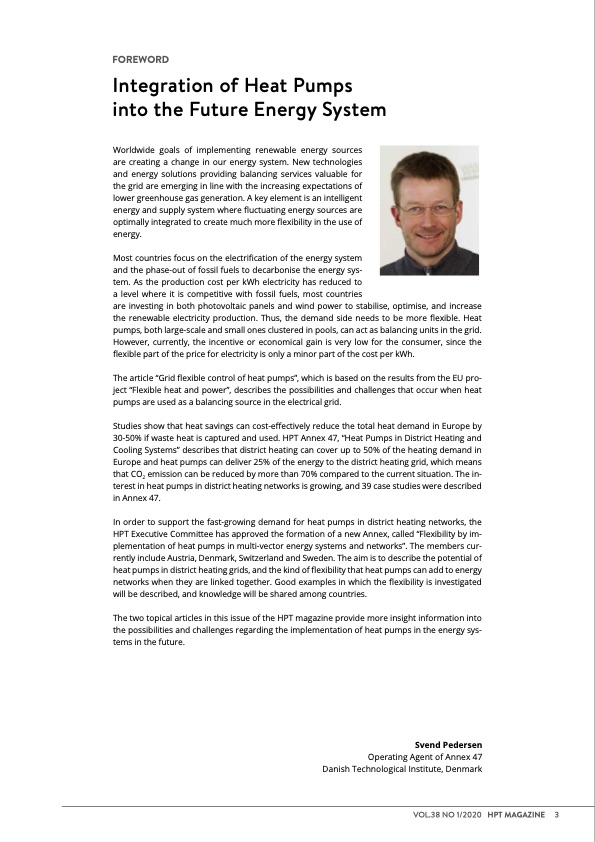
PDF Publication Title:
Text from PDF Page: 003
FOREWORD Integration of Heat Pumps into the Future Energy System Worldwide goals of implementing renewable energy sources are creating a change in our energy system. New technologies and energy solutions providing balancing services valuable for the grid are emerging in line with the increasing expectations of lower greenhouse gas generation. A key element is an intelligent energy and supply system where fluctuating energy sources are optimally integrated to create much more flexibility in the use of energy. Most countries focus on the electrification of the energy system and the phase-out of fossil fuels to decarbonise the energy sys- tem. As the production cost per kWh electricity has reduced to a level where it is competitive with fossil fuels, most countries are investing in both photovoltaic panels and wind power to stabilise, optimise, and increase the renewable electricity production. Thus, the demand side needs to be more flexible. Heat pumps, both large-scale and small ones clustered in pools, can act as balancing units in the grid. However, currently, the incentive or economical gain is very low for the consumer, since the flexible part of the price for electricity is only a minor part of the cost per kWh. The article “Grid flexible control of heat pumps”, which is based on the results from the EU pro- ject “Flexible heat and power”, describes the possibilities and challenges that occur when heat pumps are used as a balancing source in the electrical grid. Studies show that heat savings can cost-effectively reduce the total heat demand in Europe by 30-50% if waste heat is captured and used. HPT Annex 47, “Heat Pumps in District Heating and Cooling Systems” describes that district heating can cover up to 50% of the heating demand in Europe and heat pumps can deliver 25% of the energy to the district heating grid, which means that CO2 emission can be reduced by more than 70% compared to the current situation. The in- terest in heat pumps in district heating networks is growing, and 39 case studies were described in Annex 47. In order to support the fast-growing demand for heat pumps in district heating networks, the HPT Executive Committee has approved the formation of a new Annex, called “Flexibility by im- plementation of heat pumps in multi-vector energy systems and networks”. The members cur- rently include Austria, Denmark, Switzerland and Sweden. The aim is to describe the potential of heat pumps in district heating grids, and the kind of flexibility that heat pumps can add to energy networks when they are linked together. Good examples in which the flexibility is investigated will be described, and knowledge will be shared among countries. The two topical articles in this issue of the HPT magazine provide more insight information into the possibilities and challenges regarding the implementation of heat pumps in the energy sys- tems in the future. Svend Pedersen Operating Agent of Annex 47 Danish Technological Institute, Denmark VOL.38 NO 1/2020 HPT MAGAZINE 3PDF Image | Integration of Heat Pumps into the Future Energy

PDF Search Title:
Integration of Heat Pumps into the Future EnergyOriginal File Name Searched:
HPT-Magazine_no1_2020.pdfDIY PDF Search: Google It | Yahoo | Bing
CO2 Organic Rankine Cycle Experimenter Platform The supercritical CO2 phase change system is both a heat pump and organic rankine cycle which can be used for those purposes and as a supercritical extractor for advanced subcritical and supercritical extraction technology. Uses include producing nanoparticles, precious metal CO2 extraction, lithium battery recycling, and other applications... More Info
Heat Pumps CO2 ORC Heat Pump System Platform More Info
| CONTACT TEL: 608-238-6001 Email: greg@infinityturbine.com | RSS | AMP |